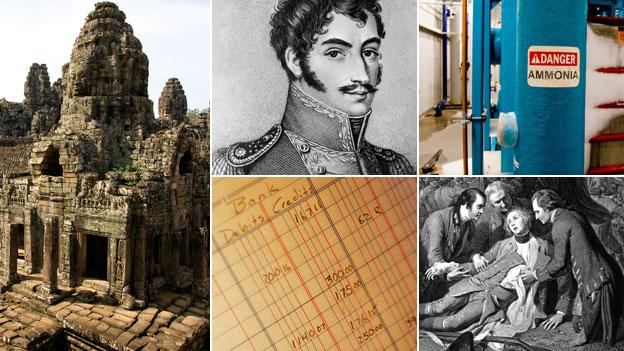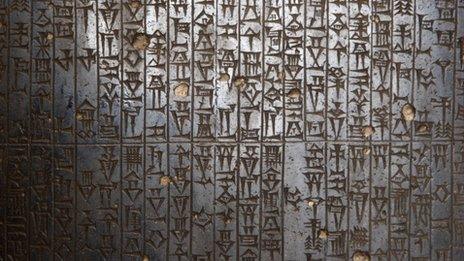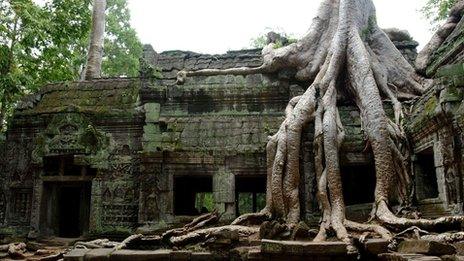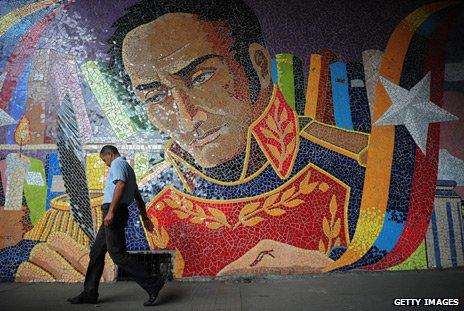10 things readers want in a history of the world
- Published
- comments

Andrew Marr's History of the World is attempting to tell the story of civilisation in eight hour-long episodes. Last week he spoke of the difficulty of choosing what to include, and what to leave out.
Charlemagne didn't make the cut. Mughal emperor Aurangzeb did. And there had to be a host of other difficult omissions.
We asked for your suggestions for often overlooked moments in world history. Here are 10.
1. Industrial ammonia

"The work of Fritz Haber and Carl Bosch in 1909 is particularly important. They paved the way for a worldwide expansion in mechanised agriculture." Ade Jones, Lydney, Glos
In 1909 Fritz Haber and Carl Bosch created a way of producing huge amounts of fertiliser by artificially synthesising ammonia from nitrogen and hydrogen.
The fertiliser increased crop yields which allowed more food to be produced for a growing population. The process was described as conjuring "bread from air".
Without the Haber-Bosch process, about 40% of people - nearly three billion - would not be alive today because we could not produce the amount of food we need, says environmental expert Professor Vaclav Smil from the University of Manitoba.
"We have to eat and drink, everything else is optional. In that sense it's the most important scientific discovery. Organic agriculture would not provide enough food to feed the world."
But Haber's contribution to agriculture is often overshadowed by his work developing chemical weapons. During World War I, he developed the use of gas for warfare and his work was later used by the Nazis to poison Jews in the gas chambers.
Of Jewish descent but "pardoned" because of his patriotic efforts in World War I, Haber was expelled from Germany after he refused to fire Jewish workers. He died of a heart attack one year later in 1934.
"We should remember his peaceful efforts before the Great War and recognise his contributions to science, useful for the whole of humanity to stave off possible famine," says Haber's godson, the historian Fritz Stern.
"He was a prime example of the complexities and contradictions of a scientist in wartime."
2. Andreas Hofer, rebel Austrian leader
"The story of Andreas Hofer deserves to be much more widely told." Dr Andrew Bellenkes, Pinswang, Austria
In 1809 Andreas Hofer led a rural rebel army to fight against Napoleon's troops to try and claim back Tyrol, a region of Austria that had been given to the German state of Bavaria.
An innkeeper in the countryside, his army was made up mostly of peasant workers and farmers. They only had improvised weapons and primitive military tactics.
For a short period in 1809 he ruled the land, announced new laws and made his own coins. But his success was short lived, and less than a year later, in exile, he was betrayed and executed.
Today he is celebrated as a hero. He has museums, books, streets and hotels named after him, but not many outside of Austria know who he is.
"If you look to Europe during the Napoleonic era, Tyrol was not of economic importance, it was just keeping the traffic routes between the North and South open," says historian and director of the Tiroler Landesmuseen, external, Wolfgang Meighoerner.
3. Alhazen and his work on optics
"The great Arabic scientific work of the 10th Century, and in particular the life of men such as Ibn al-Haytham (Alhazen)." James, Bristol
Ibn al-Haytham was born in about 965 in what is now Iraq, and is regarded by some by some as the real father of the scientific method, external, predating Francis Bacon and Rene Descartes in the 17th Century.
Al-Haytham was the first to disprove the theory that we see objects by rays of light emitted from our eyes, realising instead that we see because light enters our eyes.
No other scientist before him had used maths to prove this process, says Prof Jim Al-Khalili from the University of Surrey.
"When the great scientific revolution took place in Europe, science had advanced so much that people forgot it was built on previous knowledge."
Al-Haytham was part of the golden age of Arabic science, and while Europe was stuck in the Dark Ages, he filled the gap, says Al-Khalili.
4. Danube script
The Neolithic civilisation of central Europe (6000-3,500BC) and the enigmatic Danube script, which possibly influenced the first true writing." Jeremy Glover, Leighton Buzzard
The Danube script is a controversial subject among archaeologists, some of whom claim it is the earliest known form of writing in the world.
The early signs are found on Neolithic artefacts such as pottery and spindle whorls, concentrated in the Balkans and associated with the Vinca culture.
Some think tablets from Tartaria, in Romania, are exceptional as they "really look like 'writing'", notes James Mallory, professor of prehistoric archaeology at Queen's University in Belfast.
But he says no-one can tell for sure whether they are random symbols, a system of select magical symbols, or possibly some form of early writing.
There has also been a debate about whether they actually date to the Vinca period or were later insertions into the mound, he says.
5. Double-entry book-keeping
"Double-entry book-keeping, which revolutionised commerce first in Europe and then the world over." Philippa Sutton, Newcastle
Double-entry book-keeping, which is widely believed to have been introduced to Europe in the early 16th Century by the monk Luca Pacioli, is a financial accounting system. It recognises that all transactions have two aspects, a credit and a debit, and in a properly constituted set of books, the two sets of figures always balance.
Prof Christopher Napier from the Royal Holloway, University of London, says the system provided a standard structure for businesses and individuals to record transactions, and it helped entrepreneurs and investors to measure their capital, and the profits of their business.
Some people argue that double-entry prompted a shift in culture, Napier says, from a time when the goal was simply to earn a good living, to a culture where the goal was to maximise one's capital. But there are some historians of accounting who argue it's possible to overstate the influence of double-entry, Napier says.
6. Seven Years' War
"The Seven Years War was truly the first WORLD war and is overlooked in history." Cleggy, Northfleet, Kent
The Seven Years' War (1756-1763) involved all the great powers of Europe and saw France, Austria, Russia and Sweden on one side, and Britain, Prussia and Hanover on the other.
Michael Ball, curator of Britain's National Army Museum, external, says the Seven Years' war could arguably be seen as the first world war, "not in the sense of the 20th Century wars, which saw entire nations mobilised for war, but in terms of geography".
"The battles affected North America, India, the Caribbean, the Philippines and large parts of central Europe," he says.
Prof Mark Knights, of the University of Warwick, says the Seven Years' War could also be seen as the first world war due to its "shockingly high" casualties.
"Estimates vary but it is likely that more than a million people died," he says.
The result of the fighting, which saw Britain acquire Canada from the French and control all of North America east of the Mississippi, was also "very significant", according to Ball, and ultimately led to the American war of Independence.
It also saw Britain become, arguably, the first world power, he says.
7. The Kingdom of Axum
"Civilisations are neglected. What about Axum?" Berhanu Tessema, Addis Ababa
The Kingdom of Axum (or Aksum) rose to prominence as a trading nation in the 1st Century, and at its height became the greatest market of north-eastern Africa.
Its most renowned surviving monuments are a group of memorial obelisks, or stelae.
There are many reasons for including Axum in any world history, says James Burns, author of A History of Sub-Saharan Africa.
The kingdom represents a significant and highly innovative urban civilisation.
"Its economy was based on the cultivation of crops grown exclusively in the Ethiopian highlands, supplemented with cereals and technologies imported from Asia. It was one of Rome's great trading partners, and they rose and fell in close parallel," he says.
The kingdom was one of the earliest regions of Christian conversion in Africa. "The image of an isolated Christian kingdom captured the imagination of Christians in Europe throughout the Middle Ages", he says.
8. The law code of Hammurabi

"The law code of Hammurabi ought to be in too - the first time a ruler laid down a coherent set of laws which all his people must live by." Ben Gate, Pontypridd
A basalt stele (slab) protrudes into Paris' Louvre like a thumb. On it is the earliest truly extensive documented set of laws of the ancient world, written in Akkadian.
It is commonly referred to as the Law Code of Hammurabi, but some experts argue it's not really a law code at all. It does however provide an incomparable insight into life and justice during King Hammurabi's reign (1792-1750BC) as first ruler of the Babylonian Empire.
The stele sets out the famous principle of "an eye for an eye". But also included are familiar concepts of evidence-based justice and giving testimony under oath - even provisions for the maintenance of divorced wives.
There were precursors to Hammurabi's laws, explains Dr Frances Reynolds, Assyriology expert at Oxford University, but the stele and 130,000 clay tablet documents from the period establish the king as a "fantastic administrator".
It perhaps explains why he adorns the wall of the American Supreme Court, suggests Reynolds.
9. Rise of the Khmer empire and creation of Angkor Wat

"The Khmer Empire reaching its peak in the 12th Century and its influence on south-east Asia." Paul McShane, Edinburgh
Thousands of backpackers and awed holidaymakers have stood and gazed at the massive temple complex of Angkor Wat deep inside the Cambodian jungle.
The Angkor temples are legacies of the Khmer Empire, which dominated south-east Asia from the 9th Century.
"One of the first and certainly the most important classical civilisation of southeast Asia, it set the standards by which kingdoms and societies that came after measured themselves", says Dr Charney, an expert from SOAS.
Angkor became the "largest pre-industrial urban complex in the world", says Cambridge PhD student Mary Beth Day, featuring the "most sophisticated hydraulic engineering and water management system". The Khmer could collect and store water across 1,000 square km, channelling it directly to rice paddies.
Yet the empire's demise remains a "contentious issue", says Day, with many details shrouded in mystery.
10. The life of Simon Bolivar

"Simon Bolivar's liberation of five countries from the Spanish yoke." Luis Rodriguez, Leigh-on-Sea
Inspired by European enlightenment philosophy, Caracas-born Simon Bolivar helped liberate his people from the Spanish Empire, gaining independence for the modern-day nations of Bolivia, Colombia, Ecuador, Panama, Peru and Venezuela.
His political rule was less successful. Unable to fend off factional enemies and increasingly dictatorial, Bolivar died awaiting exile in 1830, "disillusioned that he was unable to maintain the ideals of freedom, liberty and equality", says Dr Matthew Brown, a Latin America expert, external at Bristol University.
Bolivar's impact was nevertheless vast.
The "most significant figure" to emerge from Latin America, he was even "more important than [US President George] Washington", says Anthony McFarlane, emeritus professor at Warwick University.
He played a critical role in the decline of the Spanish Empire, which in turn marked a huge shift in global imperial relations. Bolivar's leadership also served as a "model" for later anti-colonialist movements, adds McFarlane.
Reporting by Tom Heyden, Vanessa Barford and Melissa Hogenboom